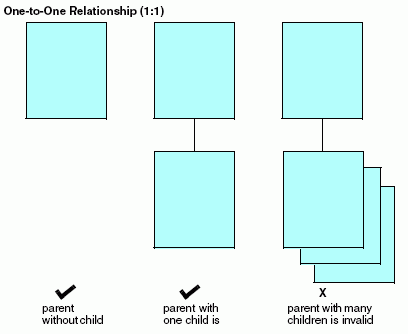|
In this section: |
Fields in a segment have a one-to-one relationship with each other. Segments can also exhibit a one-to-one relationship. Each instance of a parent segment can be related to one instance of a child segment, as shown in the following diagram. Because the relationship is one-to-one, the parent instance is never related to more than one instance of the child. However, not every parent instance must have a matching child instance.
The child in a one-to-one relationship is referred to as a unique segment, because there can never be more than a single child instance. The following diagram illustrates the concept of a one-to-one relationship.

Example: Understanding a One-to-One Relationship
In the EMPLOYEE data source, each EMPINFO segment instance describes one employee ID number, name, current salary, and other related information. Some employees have joined the Direct Deposit program, which deposits their paycheck directly into their bank accounts each week. For these employees, the data source also contains the name of their bank and their account number.
Because only one set of bank information is required for each employee (since each employee paycheck is deposited into only one account), there is a one-to-one relationship between employee ID fields and bank information fields. Because there is limited participation in the Direct Deposit program, only some employees have bank information. Most of the employees do not need the bank fields.
The data source was designed with storage efficiency in mind, and so the bank fields have been put into a separate segment called FUNDTRAN. Space is only used for the banking information, creating an instance of FUNDTRAN, if it is needed. However, if banking fields are used in the parent segment (EMPINFO), the EMPINFO segment for each employee reserves space for the banking fields, even though those fields are empty in most cases. This concept is illustrated in the following diagram.
